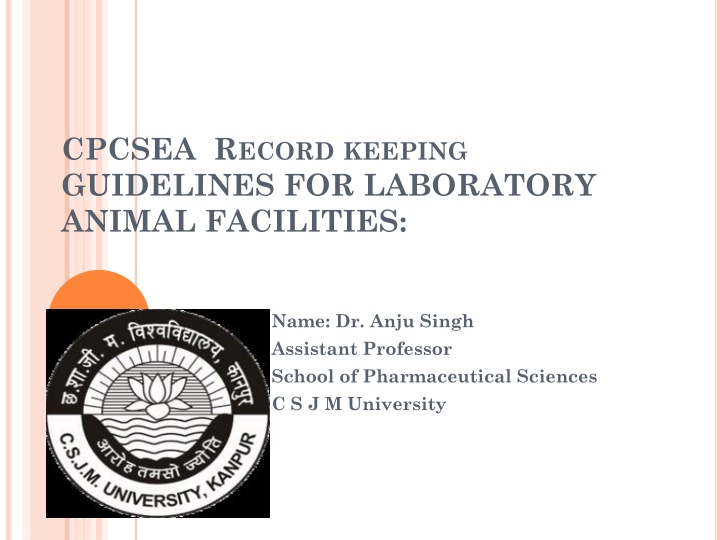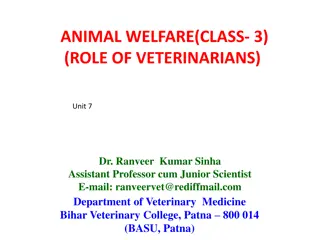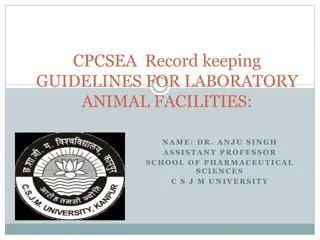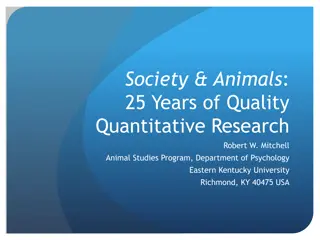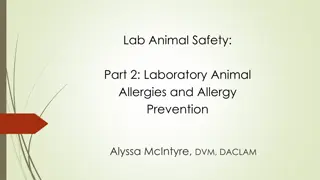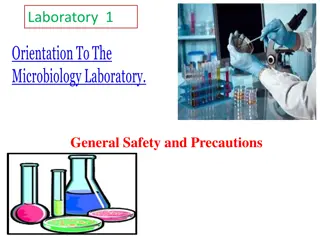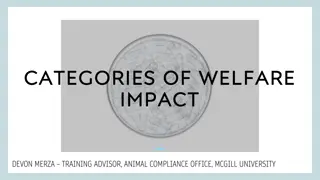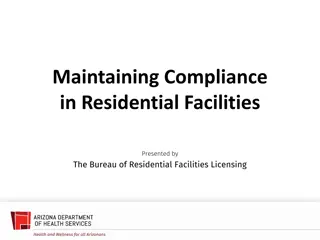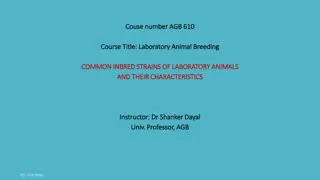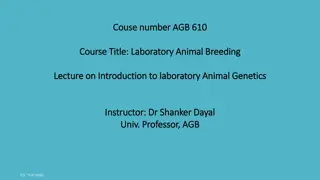Laboratory Animal Facilities Record-keeping Guidelines
Guidelines for maintaining records in laboratory animal facilities include provisions for animal housing, staff records, health monitoring, and standard operating procedures. Compliance with CPCSEA regulations ensures ethical review procedures for animal research proposals. Focus is on providing a safe, comfortable environment for animals, monitoring staff and animal health, and keeping detailed records for breeding, experiments, care, and management.
Download Presentation

Please find below an Image/Link to download the presentation.
The content on the website is provided AS IS for your information and personal use only. It may not be sold, licensed, or shared on other websites without obtaining consent from the author.If you encounter any issues during the download, it is possible that the publisher has removed the file from their server.
You are allowed to download the files provided on this website for personal or commercial use, subject to the condition that they are used lawfully. All files are the property of their respective owners.
The content on the website is provided AS IS for your information and personal use only. It may not be sold, licensed, or shared on other websites without obtaining consent from the author.
E N D
Presentation Transcript
CPCSEA RECORD KEEPING GUIDELINES FOR LABORATORY ANIMAL FACILITIES: Name: Dr. Anju Singh Assistant Professor School of Pharmaceutical Sciences C S J M University
Animals house plan: Provide a comfortable environment Provide an escape proof enclosure that confines animal safety Provide easy acces to food and water; Provide adequate ventilation temperature, urination, defecation, and reproduction; Keep the animals dry . Animals staff records : All the staff who help in the maintenance of the animal house (technical or non technical) CPCSEA says they should all data maintain.
Health records of staff and animals: According to CPCSEA routinely check the health of all staff and all animals . Staff health records include the pre-placement medical history, results of physical examinations, medical surveillance and other screening data, vaccination records, information on assessments made at the request of the employer or the employee, exposure follow-up records, documentation of observations and counseling, and any other health records which come under the control are initiated by the occupational health professional, regardless of the source.
ALL SOPS RELEVANT TO EXPERIMENTS, CARE, BREEDING AND MANAGEMENT OF ANIMALS: To contribute to the effective functioning of the Institutional Animal Ethics Committee (IAEC) so that a standard and consistent ethical review procedure for animal research is practised for all proposals dealt by the Committee as prescribed by the CPCSEA under PCA Act 1960 and Breeding and Experimentation Rules 1998. As defined in Breeding of and Experiments on Animals (Control and Supervision) Rules, 1998 "Institutional Animals Ethics Committee" means a body comprising of a group of persons recognized and registered by CPCSEA in an establishment which is constituted and operated in accordance with procedures specified for the purpose by the Committee. IAEC is required to monitor the research throughout the study and after completion of study through periodic reports and visit animal house and laboratory where the experiments are conducted.
BREEDING, STOCK, PURCHASE AND SALES RECORDS: Mating of good quality animals to produce highly productive and suitable animals for enhancement of overall performance in the subsequent generations and to augment production and profitability is termed animal breeding. Breeding of and Experiments on Animals (Control and Supervision) Rules 1998, as amended, approval of animal house facilities by CPCSEA is required to be obtained, for premises where experiments are to be conducted. According to CPCSEA to maintain the record of animals stock , purchase records and sales records.
MINUTES OF INSTITUTIONAL ANIMALS ETHICS COMMITTEE MEETINGS : IAEC should provide independent, competent and timely review of the ethics of a proposed study before the commencement of the same and regularly monitor the ongoing studies. IAEC will review and approve all research proposals involving animal experiments with a view to assure quality maintenance and welfare of animals used in laboratory studies while conducting research. Conduct of meeting: The Member Secretary will be responsible for organizing the meetings, maintaining the records and communicating with all concerned. He/she will prepare the minutes of the meetings and get them approved by the Chairperson & nominee of CPCSEA before communicating to the Principal Investigator. A copy of minutes is required to be sent to Member Secretary CPCSEA within 15 days of the meeting, otherwise, the meeting will not be considered valid.
CONDUCTED WITH THE NUMBER OF ANIMALS USED (COPY OF FORM D): Record of Animals Acquired and Experiments performed: (to be maintained by the Investigator) followings steps: Date No. of animals acquired (specify Species, Sex and Age) Name, Address and Registration No. of the Breeder from whom acquired with Voucher/ Bill No. Date and IAEC approval number Duration of experiment Name and address of the person authorized to conduct the experiment Signature of the Investigator certifying that all conditions specified for such an experiment have been complied.
CLINICAL RECORD OF SICK ANIMALS : Veterinary clinical examination relies on knowledge of Anatomy, Physiology, Pathology and Animal behavior, skills in the methods and techniques of clinical examination, clinical sign and pathogenesis of the diseases which are the basic requirements for clinician in his/her good diagnostic approach and maintain the data of sick animals. Training record of staff involved in animal activities The lab animal facility manager is sometimes held directly responsible for the outcomes of training within the facility. For example, the manager could be the supervisor of one or more trainers, could manage the budget of the training department, or could be a part- or full-time trainer. In these capacities, here is a list of items, any of which the manager could anticipate doing.
The reader is encouraged to add others and make a personal list. Being engaged with the day-to-day operations regarding training Reviewing training records and compiling reports to submit to regulatory agencies or upper management Maintaining an LMS, including collection and entry of learner data and information Engaging personally in training activities Establishing and contributing to the culture of training within smaller departments or for the whole institution Walking the talk about training, sharing its importance and significance Conducting training sessions Designing curriculum Anticipating and identifying training needs
Recognizing that not all persons learn the same way, nor do all trainers teach the same way Recognizing that training subjects are wide and varied (e.g., consider the different needs for a highly secured lab, a traditional barrier, and wildlife habitats) Directly managing the training, which is an active process, or supporting it more passively, as in training management Supporting trainers, which includes providing resources, committing time, and helping with coordination Facilitating learning, including arranging work time for study, mentoring, and planning Enabling learning in both formal (e.g., classrooms and professional conferences) and informal (e.g., spontaneous hallway conversations and e-mailing materials) settings.
THANK YOU .
